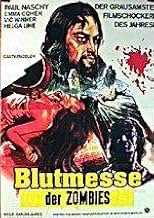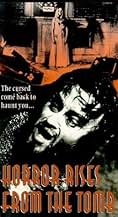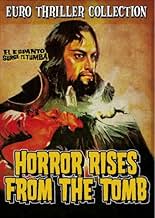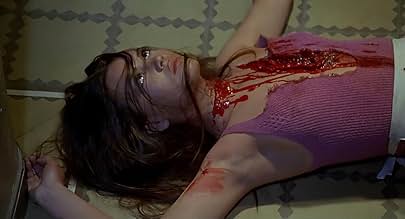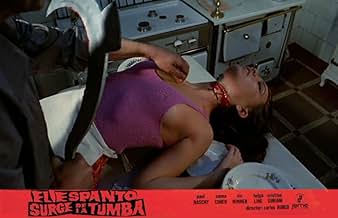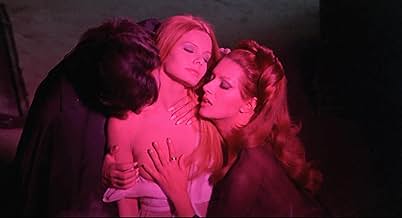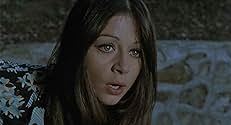NOTE IMDb
5,6/10
1,7 k
MA NOTE
Ajouter une intrigue dans votre langueA warlock's severed head is unearthed centuries after his execution. Reanimated, it seeks to reunite with its body, wreaking havoc as a group encounters its sinister quest.A warlock's severed head is unearthed centuries after his execution. Reanimated, it seeks to reunite with its body, wreaking havoc as a group encounters its sinister quest.A warlock's severed head is unearthed centuries after his execution. Reanimated, it seeks to reunite with its body, wreaking havoc as a group encounters its sinister quest.
- Réalisation
- Scénario
- Casting principal
Víctor Barrera
- Maurice Roland
- (as Vic Winner)
- …
Betsabé Ruiz
- Silvie
- (as Betsabe Ruiz)
María José Cantudo
- Chantal
- (as Maria Jose Cantudo)
Ramón Centenero
- André Govar
- (as Ramon Centenero)
Marcia Bell
- Marcia
- (non crédité)
Pedro Bravo
- Efebo
- (non crédité)
Avis à la une
In the Middle Ages, a man is hanged for performing an incredible long list of Satanic acts. He is hanged and his body is buried away from his head. In the future (the 1970s), the new owner of the land is a skeptic and does not believe in psychics. So he attends a séance, and then to disprove that she spoke to the dead sorcerer, they seek out the head where she claims it was buried. This, of course, is a bad idea.
This is the first of many collaborations between Naschy and director Carlos Aured; it was also the first time Aured took over full directing duties after being assistant to León Klimovsky. Paul Naschy wrote the story and had the script rushed out in about two days while he was pumped full of amphetamines. According to Naschy, this hurry was requested by producer José Antonio Pérez Giner, who needed a script immediately in order to create a production company.
Some say the film seems to have been inspired by Will Cowan's "The Thing That Couldn't Die" (1958). Naschy never confirmed or denied this, but rather pointed to Luis Bunuel's "Exterminating Angel" (1962) as an influence. He also took inspiration from the historical serial killer Gilles de Rais, a figure who would return in Naschy's "Blue Eyes of the Broken Doll" (1974) the following year.
Naschy stars in three roles. You probably best know Naschy as the wolfman, Waldemar Daninsky. But he equally loved this role, which he would reprise years later. His companion is Helga Line, who appeared opposite Barbara Steele in "Nightmare Castle" (1965), and then starred as the spy Natasha in the Gothic feature "Horror Express" (1972). Rounding out the cast is activist-actress Emma Cohen, who appears as Elvira (a name Naschy used frequently in his scripts). Cohen had just finished Eloy de la Iglesia's "The Cannibal Man" (1972), which found itself on the notorious video nasty list. She also had a bit part as a vampire bride in Jess Franco's "Count Dracula" (1970).
For many years, the easiest way to see the film was on DVD in what was considered a public domain release. The quality was rather poor, the aspects were off, and perhaps worst of all, it turns out that the film was never supposed to be public domain. But if you could look past the film quality, the plot is interesting enough and you have to really like the effort the villagers go to keeping them from the burial grounds. They are saved from muggers by a group of vigilantes who really aren't any more safe to be around. And then, once one of them becomes possessed by the sorcerer's spirit, it is just a world of pain.
The 2017 Blu-ray release from Scream Factory is something of a godsend. The film looks as good or better than it ever did. Audiences have the option to watch the clothed or unclothed versions. Roughly eight minutes of footage not seen in the public domain release is properly back in the footage. This is all-around a top-notch film and one that should see a growing appreciation now that fans will see it in its full glory rather than as a third- or fourth-generation duplicate that was poorly "remastered".
This is the first of many collaborations between Naschy and director Carlos Aured; it was also the first time Aured took over full directing duties after being assistant to León Klimovsky. Paul Naschy wrote the story and had the script rushed out in about two days while he was pumped full of amphetamines. According to Naschy, this hurry was requested by producer José Antonio Pérez Giner, who needed a script immediately in order to create a production company.
Some say the film seems to have been inspired by Will Cowan's "The Thing That Couldn't Die" (1958). Naschy never confirmed or denied this, but rather pointed to Luis Bunuel's "Exterminating Angel" (1962) as an influence. He also took inspiration from the historical serial killer Gilles de Rais, a figure who would return in Naschy's "Blue Eyes of the Broken Doll" (1974) the following year.
Naschy stars in three roles. You probably best know Naschy as the wolfman, Waldemar Daninsky. But he equally loved this role, which he would reprise years later. His companion is Helga Line, who appeared opposite Barbara Steele in "Nightmare Castle" (1965), and then starred as the spy Natasha in the Gothic feature "Horror Express" (1972). Rounding out the cast is activist-actress Emma Cohen, who appears as Elvira (a name Naschy used frequently in his scripts). Cohen had just finished Eloy de la Iglesia's "The Cannibal Man" (1972), which found itself on the notorious video nasty list. She also had a bit part as a vampire bride in Jess Franco's "Count Dracula" (1970).
For many years, the easiest way to see the film was on DVD in what was considered a public domain release. The quality was rather poor, the aspects were off, and perhaps worst of all, it turns out that the film was never supposed to be public domain. But if you could look past the film quality, the plot is interesting enough and you have to really like the effort the villagers go to keeping them from the burial grounds. They are saved from muggers by a group of vigilantes who really aren't any more safe to be around. And then, once one of them becomes possessed by the sorcerer's spirit, it is just a world of pain.
The 2017 Blu-ray release from Scream Factory is something of a godsend. The film looks as good or better than it ever did. Audiences have the option to watch the clothed or unclothed versions. Roughly eight minutes of footage not seen in the public domain release is properly back in the footage. This is all-around a top-notch film and one that should see a growing appreciation now that fans will see it in its full glory rather than as a third- or fourth-generation duplicate that was poorly "remastered".
Paul Naschy exchanges his Waldemar Daninsky werewolf persona for that of medieval occultist Alaric De Marnac (which he would play again, years later, in PANIC BEATS [1983]) and that of his modern-day descendant Hugo, resulting in one of his most eclectic scripts taking in witchcraft, spiritualism, a powerful amulet, a scythe-wielding killer and a horde of zombies, among others - all of which are rather jumbled together without much consideration for logic, but it does make for a colorful and thrill-packed show. However, as is often the case with this type of film, the languid pace coupled with variable acting and the awkward dubbing also entails that HORROR RISES FROM THE TOMB comes off as an uneven - but, ultimately, not disagreeable - viewing experience.
The film positively drips with atmosphere right from the opening sequence - set in 15th century France and showing Alaric's execution along with his mistress/associate, played by Helga Line - down to the couple's modern-day come-uppance during the busy climax which takes place in de Marnac's remote estate. Other notable moments include: the seance during which Alaric is invoked by Hugo; the individual scenes in which the evil duo are revived, made possible by discreet use of (rather unsophisticated) special effects but which still manage to get the job done nicely; their stylized seduction of one of the girls who tags along with the latest member of the de Marnac family (who ostensibly travels to the castle in order to prove that his ancestor's evil influence is no more); and, of course, the various gory murders and zombie attacks which pepper the film's running time.
Featured in the cast, a staple of "Euro-Cult" cinema, is a bevy of beautiful ladies who are often seen lounging in various states of undress: Helga Line makes quite an impression as the villainous Mabille, but my favorite remains Emma Cohen (later star of one of Jess Franco's best films, the psychological thriller THE OTHER SIDE OF THE MIRROR [1973]) who exhibits sweetness and vulnerability in equal measures throughout - while also serving as Hugo's requisite love interest - and, by the film's end, is actually the sole survivor (albeit emotionally scarred, as can be witnessed from the final shot) of the mayhem.
This and THE CRAVING (1980; see below) have certainly made me game to check out some more Paul Naschy flicks. What would you experts recommend that I try next?
The film positively drips with atmosphere right from the opening sequence - set in 15th century France and showing Alaric's execution along with his mistress/associate, played by Helga Line - down to the couple's modern-day come-uppance during the busy climax which takes place in de Marnac's remote estate. Other notable moments include: the seance during which Alaric is invoked by Hugo; the individual scenes in which the evil duo are revived, made possible by discreet use of (rather unsophisticated) special effects but which still manage to get the job done nicely; their stylized seduction of one of the girls who tags along with the latest member of the de Marnac family (who ostensibly travels to the castle in order to prove that his ancestor's evil influence is no more); and, of course, the various gory murders and zombie attacks which pepper the film's running time.
Featured in the cast, a staple of "Euro-Cult" cinema, is a bevy of beautiful ladies who are often seen lounging in various states of undress: Helga Line makes quite an impression as the villainous Mabille, but my favorite remains Emma Cohen (later star of one of Jess Franco's best films, the psychological thriller THE OTHER SIDE OF THE MIRROR [1973]) who exhibits sweetness and vulnerability in equal measures throughout - while also serving as Hugo's requisite love interest - and, by the film's end, is actually the sole survivor (albeit emotionally scarred, as can be witnessed from the final shot) of the mayhem.
This and THE CRAVING (1980; see below) have certainly made me game to check out some more Paul Naschy flicks. What would you experts recommend that I try next?
The living head of a minion of Satan put to death centuries ago is unearthed. A nightmare ensues for a group of people as the head sets forth to reunite with it's body.
Sadly, most people in this world will never know the immense joy that this film can bring...but for the luckier few of us, this zany little Gothic horror picture delivers the goods with the very best of them. How can one go wrong with cackling disembodied heads, graphic scythe murders, zombie mayhem, and luscious babes roaming the night in their sheerest Frederick's of Hollywood naughties? Grand entertainment, as only the Europeans of the 1970s could create, and an absolute must-see for fans of crazed drive-in culture...there's not a single frame of the film which doesn't look like it was ripped straight from the pages of a Golden-Age horror comic book, and hooray for that.
Rates a solid 7 out of 10 as I see it.
Sadly, most people in this world will never know the immense joy that this film can bring...but for the luckier few of us, this zany little Gothic horror picture delivers the goods with the very best of them. How can one go wrong with cackling disembodied heads, graphic scythe murders, zombie mayhem, and luscious babes roaming the night in their sheerest Frederick's of Hollywood naughties? Grand entertainment, as only the Europeans of the 1970s could create, and an absolute must-see for fans of crazed drive-in culture...there's not a single frame of the film which doesn't look like it was ripped straight from the pages of a Golden-Age horror comic book, and hooray for that.
Rates a solid 7 out of 10 as I see it.
Jacinto Molina, more commonly known as Paul Nasty (err
I mean, Naschy) strikes again with this ultra-bizarre and ultra-deranged Spanish exploitation effort. The script of "Horror Rises from the Tomb" is incoherent as hell, there isn't a single interesting or well-written dialog to be heard, acting & directing are both extremely shabby and the supposedly malevolent witches, zombies and other unidentifiable types of monsters evoke more laughs than scares. And yet, despite all these abnormalities (and more
), "Horror Rises from the Tomb" is a vintage and purely entertaining gem of 70's horror cinema! Naschy wrote the oddball script himself and stars as no less than THREE different descendants of the noble French de Marnac family. During the fairly atmospheric opening set in the 15th Century, we witness how a malicious Alaric (Naschy) and his mistress are brutally executed for practicing witchcraft. Several years later, Hugo (Naschy again) invites three of his friends to join him for a vacation at his ancient family estate somewhere in rural France. Quite a lot of awkward and totally irrelevant things occur, but the bottom line is: Alaric de Marnac's decapitated head is still alive in a chest, buried in the large cemeteries surrounding the estate, and its hypnotizing powers turns people into docile yet bloodthirsty zombies. The film is quite bad and pointless, but at least there's always something going on to entertain you. Whether it's the poor make-up effects on the zombies, the implausible sub plots, the sleaze footage brought on by a couple of fine looking Euro-babes or the ingenious little gimmicks, "Horror Rises from the Tomb" is never boring and never makes you regret the purchase. And who can possibly resist the sequences featuring Naschy's separated head commanding his slaves to bring him human sacrifices and to obey his every word? Take my word on it: the head-in-the-chest scenes are priceless! Some of the interior & exterior filming locations are even very enchanting and beautifully captured on camera. Most neutral viewers will probably claim this is the worst film they've ever encountered in their lives, but it's an absolute must for fans of Paul Naschy and essential 70's Euro-horror.
I really want to drum a up a little more enthusiasm for this film than is evident here. Sometimes it seems like non-genre fans see things like this and miss out on the subtleties (so to speak.) I saw this with zero expectations, having purchased it as part of a very inexpensive collection of old horror 'gems' on DVD. It was my first experience with the work of cult auteur Paul Naschy, whom I'd read about in the book IMMORAL TALES, and I was more than pleasantly surprised. Fans of Jean Rollin, Coffin Joe, the Blind Dead series and Fulci's Gates of Hell will be glad they took the 90mins. to soak this one in.
One concept I've always loved is the premise that all the horrible events in a story are the work of black magic, or evil spirits-as this pretty much opens the door to anything, with a minimum of necessary exposition. Horror Rises From The Tomb has great location shots on misty swampland, majestic castles and beautiful long-haired women sleepwalking in see-through nightwear. These are a few of my favorite things. Yours too? I also love the way a red light precedes the every arrival of the evil du Margnac. There is even a brief, but eerily effective zombie sequence.
It's these little touches that a true horror fan will appreciate.
One concept I've always loved is the premise that all the horrible events in a story are the work of black magic, or evil spirits-as this pretty much opens the door to anything, with a minimum of necessary exposition. Horror Rises From The Tomb has great location shots on misty swampland, majestic castles and beautiful long-haired women sleepwalking in see-through nightwear. These are a few of my favorite things. Yours too? I also love the way a red light precedes the every arrival of the evil du Margnac. There is even a brief, but eerily effective zombie sequence.
It's these little touches that a true horror fan will appreciate.
Le saviez-vous
- AnecdotesThe film was shot in the dead of winter at Paul Naschy's own country home located in the Lozoya Valley, north of Madrid. It was eventually sold in the late 80's.
- GaffesMaurice approaches his unfinished painting and finishes it in half a minute, but the difference between the two is so big that it's obvious he didn't actually finish it in that short amount of time.
- ConnexionsEdited into Hexen Arcane: Horror Rises from the Tomb (2020)
Meilleurs choix
Connectez-vous pour évaluer et suivre la liste de favoris afin de recevoir des recommandations personnalisées
- How long is Horror Rises from the Tomb?Alimenté par Alexa
Détails
Box-office
- Montant brut mondial
- 245 371 $US
- Durée
- 1h 35min(95 min)
- Mixage
- Rapport de forme
- 1.85 : 1
Contribuer à cette page
Suggérer une modification ou ajouter du contenu manquant

